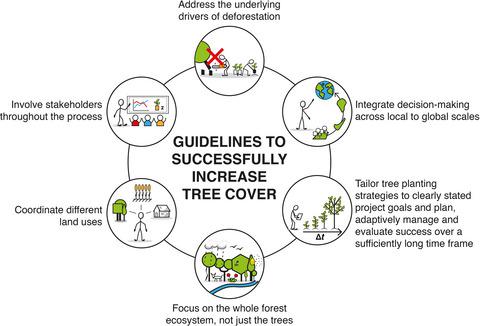当前位置:
X-MOL 学术
›
J. Appl. Ecol.
›
论文详情
Our official English website, www.x-mol.net, welcomes your feedback! (Note: you will need to create a separate account there.)
Guidance for successful tree planting initiatives
Journal of Applied Ecology ( IF 5.7 ) Pub Date : 2020-07-27 , DOI: 10.1111/1365-2664.13725 Pedro H. S. Brancalion 1 , Karen D. Holl 2
中文翻译:

成功植树计划的指南
更新日期:2020-07-27
Journal of Applied Ecology ( IF 5.7 ) Pub Date : 2020-07-27 , DOI: 10.1111/1365-2664.13725 Pedro H. S. Brancalion 1 , Karen D. Holl 2
Affiliation

|
- A growing number of initiatives at global, regional and national scales propose to plant millions, billions or even trillions of trees as a simple solution to resolve complex environmental problems. However, tree planting is much more complicated than it seems.
- We summarize the multifaceted decision‐making process needed and offer guidelines to increase the success of the proposed ambitious efforts to increase tree cover world‐wide.
- Given the varied definitions of and motivations for tree planting, it is critical that stakeholders work together to clearly define the biophysical and socioeconomic goals of each project. Then a series of questions must be addressed about where and how (e.g. planting trees vs. allowing for natural forest regrowth) to most effectively achieve these goals and minimize unintended negative consequences, as well as how, when and by whom success of efforts will be evaluated.
- Key guidelines to successfully increase tree cover include: (a) first addressing the underlying drivers of deforestation; (b) integrating decision‐making across scales from local to global; (c) tailoring tree planting strategies to clearly stated project goals and planning, adaptively managing and evaluating success over a sufficiently long timeframe; (d) focusing on the forest ecosystem as a whole, and not just the trees; (e) coordinating different land uses and (f) involving stakeholders at all stages of the planning process.
- Synthesis and applications. Tree planting, along with other strategies to increase tree cover in appropriate locations and contexts, can make a valuable contribution to ensuring the ecological and social well‐being of our planet in coming decades, but only if these efforts are considered as one component of multifaceted solutions to complex environmental problems and are carefully planned, implemented and monitored over a sufficiently long time‐scale with stakeholder engagement and broader consideration of socio‐ecological complexities.
中文翻译:

成功植树计划的指南
- 在全球,区域和国家范围内,越来越多的倡议提议种植数百万,数十亿甚至数万亿的树木,作为解决复杂环境问题的简单解决方案。但是,植树比看起来要复杂得多。
- 我们总结了所需的多方面决策过程,并提供了指导方针,以提高拟议的雄心勃勃的努力在全球范围内增加树木覆盖率的成功。
- 鉴于植树的定义和动机各不相同,至关重要的是,利益相关者必须共同努力,明确定义每个项目的生物物理和社会经济目标。然后,必须解决一系列问题,例如在何处以及如何(例如种植树木与允许自然森林再生)最有效地实现这些目标并最大程度地减少意外的负面影响,以及如何,何时以及由谁来取得成功。评估。
- 成功增加树木覆盖率的关键准则包括:(a)首先解决森林砍伐的潜在驱动因素;(b)整合从地方到全球的各种规模的决策;(c)制定植树策略,以明确说明项目目标和计划,在足够长的时间内适应性地管理和评估成功;(d)关注整个森林生态系统,而不仅仅是树木;(e)协调不同的土地用途,以及(f)在规划过程的所有阶段让利益相关者参与。
- 综合与应用。植树以及其他在适当位置和环境中增加树木覆盖率的策略,可以为确保未来几十年地球的生态和社会福祉做出宝贵贡献,但前提是必须将这些努力视为多方面的组成部分利益相关者的参与以及对社会生态复杂性的更广泛考虑,并在足够长的时间范围内仔细计划,实施和监控解决复杂环境问题的解决方案。



























 京公网安备 11010802027423号
京公网安备 11010802027423号